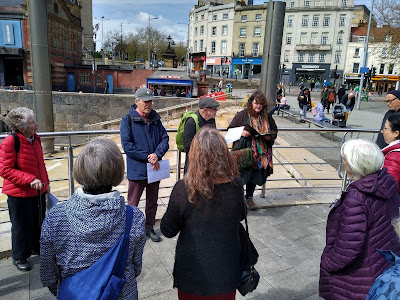One year and thirteen days after the last IsamBards in the City walk, we found ourselves at it again, on Shakespeare Day this time, and with our full complement of Bards this time too.
This time we started at Electricity House, a Grade II listed 1930s landmark, which we always called the SWEB building when I was growing up in the 1960s and 70s, and which is now, inevitably, 'luxury student accommodation'.
We started with an introduction from Professor Lucy English, Poetry Queen of Dragons and Joint Director of the Lyra Bristol Poetry Festival, of which our walk was one of the events, and we were off, starting with David Johnson who gave a potted poetry history of Electricity House.
Dominic conjures an Electric Fish Market
This is me reading a poem about nearby Christmas Steps.
We then wandered down the Centre to our next stopping point, the now empty plinth where the statue of notorious slaver, Edward Colston, once stood.
Pameli reading 'In the Centre of the City'
Remembering George Floyd
Cwtch enthralled by the story of what happened here before she was born
It was then time to head to our next stop, down by the statue of Neptune and the Hippodrome.
Alfie the whippet studies his paws in rapt concentration ...
... although Neptune has rather rudely turned his back
Pameli reading her poem 'Mr Matchem's House of Marvels'
Our next stop was at the head of St Augustine's Reach on the Floating Harbour, which almost has a view of the Central Library and was therefore just the right spot for a communal poem protesting the threatened and revoked and then re-threatened plan of the Mayor to sell that beautiful Arts and Crafts building (which is ours, actually) and rehouse it in the empty Debenhams building, or Joneses as it used to be, over in Broadmead.
'Or sell our Central Library / sell everything it means / but beware its darkened aisles / in the library of your dreams'
Our penultimate stop was further along Narrow Quay, within sight of Pero's Bridge, where we remembered one of the few slaves in Bristol whose name (albeit only his slave name), birthplace and dates we know.
I also read a poem about a little known, but grim
episode in Bristol’s history concerning three Inuit captives – a man, a woman
from a different tribe and her infant son – who were brought to Bristol by
Captain Martin Frobisher, following his voyage to Canada in 1577. He’d planned
to present them to Queen Elizabeth I but all three died before that could
happen, within weeks of their arrival.
I was a bit disconcerted to realise we were standing right outside the room where my wedding reception was held almost 37 years ago, but then the Northerner reminded me that reading poetry in that spot was the perfect way to lay any residual ghosts and he was right.
Our final stop was nearby Queen Square, which used to be a marsh before the River Frome was diverted in the 1240s and which contains a fanciful statue of King William III dressed as a Roman Emperor and sitting on a steed, both of which points of interest were referred to in various poems.
'It was all right as these things go,' said Cwtch, 'but there was only one mention of bones and no dogs whatsoever.'
Four IsamBards


























No comments:
Post a Comment